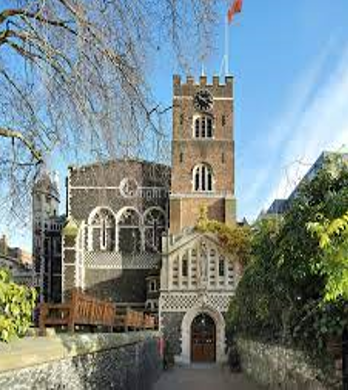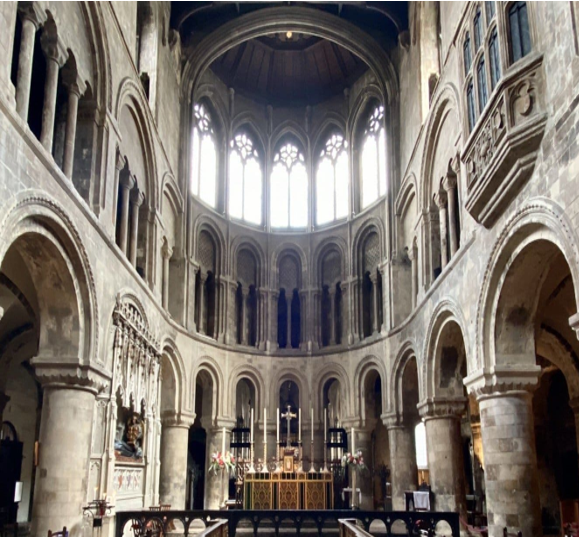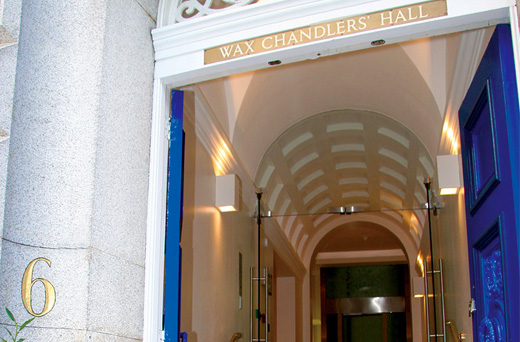On our doorsteps…The Priory Church of St. Bartholomew the Great
In our last Newsletter we began to include, what may become a regular feature, about historical places just a stone’s throw away from our Hall, and sometimes overlooked amidst the hurly burly of life.
Last time, we looked at Smithfield Meat Market, it’s past and changing future. For this newsletter we come slightly closer to Gresham Street, but still in the Smithfield area.
The Priory Church of St. Bartholomew the Great.
St Bartholomew’s was established by Rahere, a courtier and favourite of King Henry I. It is thought that it was the death of the king’s wife Matilda, followed two years later by the drowning of their heir Prince William, his brother, half–brother and sister, that prompted Rahere to renounce his profession for a more worthy life and make his pilgrimage to Rome.
In Rome, like many pilgrims, he fell ill. As he lay delirious he prayed for his life vowing that, if he survived, he would set up a hospital for the poor in London. His prayers were answered and he recovered. As he turned for home the vision of Saint Bartholomew appeared to him and said “I am Bartholomew who have come to help thee in thy straights.
I have chosen a spot in a suburb of London at Smithfield where, in my name, thou shalt found a church.” A “suburb” here means outside the walls of the City but not outside the City itself, whose boundary is defined by the “bars” (e.g. Temple Bar, Holborn Bar).
True to his word Rahere set up both a church, a priory of Augustinian canons, and the hospital. He lived to see their completion – indeed he served as both prior of the priory and master of the hospital – and it is possible that he was nursed at Barts before his death in 1145. His tomb lies in the church.
The Priory was dissolved in 1539 and the nave of the Church was demolished. The monastic buildings were largely intact and the Canons’ choir and sanctuary were preserved for parish use. Under Queen Mary, there was briefly a house of Dominican friars here, before it reverted to being a Parish Church under Queen Elizabeth I. Various parts of the building were damaged or destroyed through the centuries until the restoration began in the 19th century, first in the 1860s and then, under Sir Aston Webb, in the 1880s and 90s and on into the 20th century. St Bartholomew the Great is a living church but it also attracts those of no particular religious belief because of its architecture and sense of history.
The annual Bartholomew Fair, starting at the time of the Saint’s Day on 24th August, took place from 1133 until 1855, when it was closed down for licentiousness. The City of London revived it in 2023 for the 900th anniversary of the Priory, Church, and Hospital.
St Bartholomew the Great is a living church but it also attracts those of no particular religious belief because of its architecture and sense of history but it is far from being a museum. Unlike many other City churches, they operate services during the week and three on Sunday. It’s an inclusive church in what is probably regarded as High Anglican tradition. They have a reputation of providing excellent music and choir to accompany the services and should you ever find yourself in the City on the first Thursday of the month Choral Evensong (arguably the best service that the Church of England provides) is held at 7.00pm.
In our summer newsletter we will continue with the City Churches theme and look at “our parish church “ just around the corner, St. Vedast-Alias-Foster.
Jon Simpson – Court Assistant.





 Sillett Photography
Sillett Photography